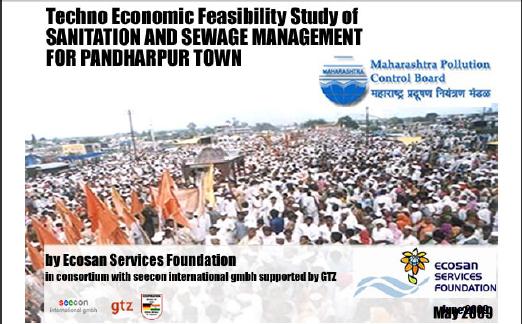 This study provides interventions to solving the sanitation crisis in the holy town of Pandharpur, situated on the banks of the Chandrabagha/Bhima river, in the state of Maharashtra, which receives more than 1.5 crore devotees annually. On any given day there are approximately 20,000 pilgrims in this Class B town. This vast floating population creates massive sanitation problems leading to environmental and hygiene issues. The study forms part of the Maharashtra State Pollution Control Board's 'Environmental Improvement Programme at Religious Places in Maharashtra' project.
This study provides interventions to solving the sanitation crisis in the holy town of Pandharpur, situated on the banks of the Chandrabagha/Bhima river, in the state of Maharashtra, which receives more than 1.5 crore devotees annually. On any given day there are approximately 20,000 pilgrims in this Class B town. This vast floating population creates massive sanitation problems leading to environmental and hygiene issues. The study forms part of the Maharashtra State Pollution Control Board's 'Environmental Improvement Programme at Religious Places in Maharashtra' project.
This report is a result of primary surveys, interviews and discussions with experts in the field of sanitation. The report is broken into10 chapters; beginning with an introduction that gives the sanitation scenario of the town, the report goes on to discuss the principles on which the recommendations are made. Known as the Bellagio Principles, these form the basis of the survey and recommendations. Key findings from the survey are converted into recommendations which form separate chapters. Pilgrim Management System is one such recommendation and forms a separate chapter.
The other chapters are:
- Proposed collection, transport, treatment and reuse system
- Block estimates
- IEC strategy
- Institutional strengthening and capacity building
- Implementation strategy
- Recommendations
The extent of the problem is clearly seen from two tables in the first chapter. These tables on flow of pilgrims to the town through the year and existing sanitation facilities of the town indicate a big demand supply gap which has resulted in a sanitation, hygiene and environmental crisis. This condition is further exacerbated by the non-functioning of the sewage treatment plant because of electricity outages and poor operation and maintenance.
Chapters 2 and 3 focus on the principles on which this sanitation crisis can be solved. Here, the Bellagio Principles are the foundation. The Principles lay importance on human dignity, quality of life, environmental security and good governance. Also waste should be considered as a resource and its management should be holistic and form part of integrated water resources, nutrient flows and waste management etc. With these principles, the study is able to identify the direct beneficiaries, which include the villages downstream of the river, other possible beneficiaries which include farmers who could use the treated sewage water and sludge, actors that may assist in operation/management, local and state authorities.
Chapter 4 is based on a key observation that devotees spend approximately 40 hours in a queue that extends 8 km to pay obeisance to their god. This leads to a lot of congestion and inconvenience. The report observes that there are 3 types of homage and determines which is the most sought after. After calculating the time spent per person in the sanctum-sanctorum, the authors suggest that a computerised ticket system be created which would not only decongest the town but would also make the pilgrimage and homage more convenient for the pilgrims. It is also suggested that camp sites be constructed at key points along the banks of the river, these camps should also have parking space as many pilgrims come in vehicles.
Chapter 5 takes up the challenge of establishing a well designed, managed and operated sanitation solution. The number of toilets required per area of the town is calculated as per the distribution of pilgrims around the town. Two types of decentralised approaches and an option of a centralised approach are offered. The decentralised approach is based on using the existing treatment plant and having decentralised technologies for new areas and for other areas not connected to the treatment plant. In the centralised approach new sewer lines and increasing the capacity of the treatment plant is suggested. The chapter also has suggestions on sludge management and use of waste water.
Chapter 6 provides the estimation of costs for the sanitation management system. The costs are not only broken down per item but also per block of the city. Also information is given on the yearly O&M costs.
Chapter 7 and 8 list out the immediate and long term steps that need to be taken to set up such a sanitation system. These include changing the perceptions on sanitation in the resident and pilgrim population, finding methods of community participation, finding the finances and institutional strengthening and capacity building.
Chapter 9 provides an implementation strategy for the setting up of such a system. The strategy is broken into immediate, short term and long term. The authors recommend the decongestion of the termple as one of the immediate steps while short term steps include construction of appropriate collection, treatment and reuse systems, as per the selected alternatives and completion of riverbank beautification. The long term steps are spread over a period of 2 to 5 years and include development of campsites.
The study ends with a list of recommendations which are a result of two stakeholder engagement meetings, in Pune and in Pandharpur during the course of the study period. The suggestions include those from the Project Team, advisory board of ESF, the client (MPCB) as well as the stakeholders. The suggestions include establishment of a Pandharpur Sanitation Committee which will have representatives from Temple Trust and Maths and be spearheaded by the Pandharpur Municipal Council. This Committee will develop a water supply and sanitation management team and also develop volunteer teams for pilgrim education etc. The recommendations for infrastructure are aimed at protecting the environment and protecting the resident and floating population through improved sanitation facilities.
Download the report here:
/articles/technoeconomic-feasibility-study-sanitation-and-sewage-management-pandharpur-town